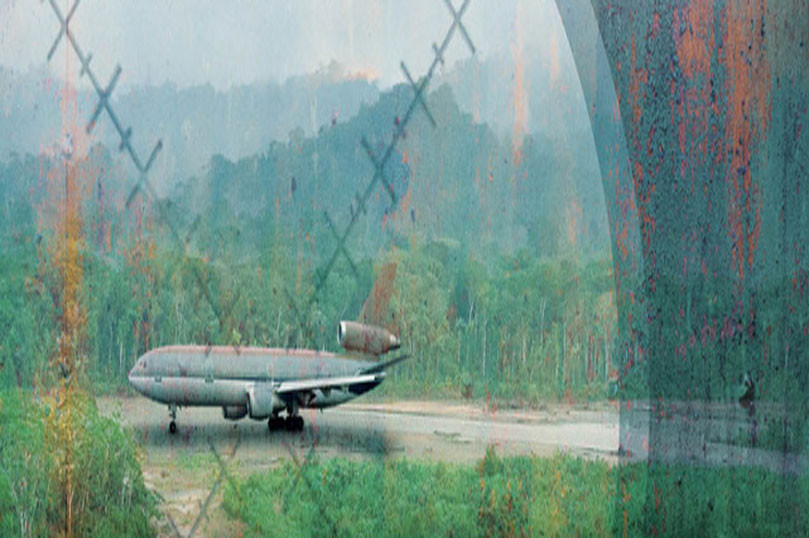 When it comes to disappearing, David Slaton has few equals. Police in three countries have written off trying to find him.
When it comes to disappearing, David Slaton has few equals. Police in three countries have written off trying to find him.
The CIA assesses two spectacles: a practiced killer leaving a trail of bodies across Europe, and a large airplane disappearing without a trace. The two affairs are increasingly seen to be intertwined.
When their worst fears are realized, they must trust the one man who can save them: David Slaton, the perfect assassin. Enjoy this excerpt of Assassin’s Silence by Ward Larsen.
ONE
Twenty months later
Centered on the sun-soaked island of Malta, the ancient city of Mdina stands tall and brusque, a defiant island of brown whose vaulted bastions amplify the country’s most prominent hill. Though incorporating no more than one square kilometer, the palaces and narrow streets of the medieval city have stood the tests of a thousand harsh summers, dozens of military campaigns, and in a more contemporary test of endurance, the annual invasion of a million tourists each year. For all these reasons, Mdina is a place in constant need of repair.
Most in demand are good stonemasons.
On the falling afternoon, with a classic portrait of burnt orange clinging to the western sky, a solitary mason put his finishing touches to the foot of an arch near the Nunnery of St. Benedict. The repair, a reissue of a simple decorative façade that bore no weight, was the kind of touch-up that had played out regularly over the last millennium. And while the cement was perhaps a more uniform mix than the mud used by craftsmen of past eras, the hammer and chisel the mason used to shape the flat faces and fitted angles were virtually unchanged, notwithstanding the likes of rubberized handles and carbide tips. Stoneworkers in other towns on the island had relented to more contemporary instruments—heavy masonry saws and compressed-air power tools—yet such advances were not favored in the Old City. The patron who today commissioned repairs here, a city formerly administered by the likes of knights and noblemen, was the Maltese Ministry for Tourism, Culture, and Environmental Affairs, a body with an unyielding eye for absolute authenticity. In a curious twist of fate, the fact that this craftsman was not a native Maltese was squarely in line with tradition. Having existed for so long at the geographic crossroads of Europe, the Middle East, and Africa, the time-tested stonework of Malta had been raised almost exclusively by journeyman masons.
The man stood back to regard his work, a chisel and damp cloth in his calloused hands. After a ten-hour day he was gray-suited in sweat and dust, the only exception being a pair of clear gray eyes, and tiny streams on his face and neck where rivulets of sweat had washed the skin clear. The heat and sun were a constant here, although in early February the Mediterranean winter was at the height of its relief. All the same, the city seemed to draw a long breath as its shadows leaned to darkness.
The mason compared the column he’d repaired to its sister four meters away. It was good, he decided. The cuts were accurate, and the color of the stone a reasonably close match. Those effects he could not simulate were the ones carved by time—the gentle erosion of mortar channels, edges nicked by handcarts, stains from spilled wine. These would come in due course.
He bent down with his hammer and chisel and made his mark next to another, an artisan’s signature that had, he guessed knowledgeably, most likely been hewed sometime in the late sixteenth century. That done, he began packing his tools in a hand case. Tomorrow he would regard his work in better light, perhaps make a few alterations, and wash things down for the last time. And then? Then he would move on to his next job—two collapsed pillars in the Catacombs of St. Paul. For a mason, Mdina and the surrounding city of Rabat were not a series of day jobs—they were a career.
A spindly young boy scurried up the street with a broom in his hand and stopped next to the mason.
“All done, sir?” he asked in Maltese.
The mason kept to the language he’d picked up over the last months, if only in a colloquial sense. “Done for the day.” He reached into his pocket, pulled out a two-euro coin, and flipped it through the air. The boy snatched it cleanly.
“When you’re done cleaning up, take the tools with you. Meet me tomorrow at the Catacombs.”
“The Catacombs? That is very far from here, sir.”
The mason grinned and reached into his pocket. His second coin was a one-euro denomination, and his second toss less accurate. Not that it mattered—the kid caught it effortlessly. Indeed, in the three months of their association he had never once missed. He was ten or eleven years old, the mason guessed, although never having raised a child himself he couldn’t say with any authority. They didn’t know each other’s names because neither had ever asked. Sir and Kid sufficed, both words conveniently shared between English and Maltese. “Kid” was a straight bean of a child with a mop of curly black hair, and he invariably appeared in worn tennis shoes and a shirt with a corporate sponsor’s name on the front and a large number on the back. He loved soccer with a passion, and lived in the Old City with his mother. That was all the tradesman knew—indeed, all he wanted to know. The kid did what he was asked to do, smiled more often than not, and showed up on time.
He was the perfect employee.
“El Classico is tonight,” the boy said, referring to the semiannual clash of Spanish soccer giants Real Madrid and Barcelona. “You should watch. Their new forward is better than Messi.”
“I’ll try to catch it,” said the mason as he raised his ladder against the crest of the arch for the day’s final inspection.
“There is a man up the street watching you.”
The mason stopped what he was doing. “A man?”
“He has been there since I brought you the water.”
“The water? That was two hours ago.”
“Yes.”
A long pause ensued. “And you think he’s watching me?”
“Oh, yes.”
The mason stood very still, his eyes locked on the sturdy stone arch. It began as no more than a tremor, a cautionary jolt he’d felt twice since arriving on the island. Once it had been a gunshot out of a quiet night, probably a misguided celebration from some drunk who didn’t realize that bullets sent into the sky still come down. The second occurrence had greater basis, a team of policemen with weapons maneuvering outside his rooming house—as it turned out, there to raid a nearby apartment where a drug dealer had bunkered up. In both instances he’d felt the surge of adrenaline, but waited with well-practiced patience until the threat was disproved.
Now he did it again. In the ensuing minutes of uncertainty, the mason went through the motions of his business. “Where is he exactly?” he asked the boy, his hand flicking away a bit of loose mortar.
“You can’t see him from here—he’s near the Cathedral Museum, sitting in the courtyard behind the gift shop. It was very shady there this afternoon, many customers. Now he is the only one remaining, and still watching you through the open door of the shop. I walked past twice to be sure.”
“He’s alone?”
“Yes. But I saw another tea cup on the table.”
Right then, the mason decided the kid had a future. One that didn’t involve kicking a ball.
The boy smiled eagerly. “You want me to go look again?”
“No,” said the mason quickly.
He considered his position. The archway he was repairing was situated at a T-shaped intersection. He glanced ahead, along the length of Triq San Pawl, and saw the gift shop with the open front door. In the opposite direction the street reached its southern end near the Xara Palace, and the third leg of the intersection was made by Triq Mesquita, a narrow cobbled path that ran toward the Piazza Mesquita. The walls bordering all these streets ran the same, indeed like every other street in Mdina, thirty-foot tan stone faces with minimal ornamentation. There were no windows at street level, and the doors came at odd intervals, brilliant blue and red invitations that the mason recognized as no more than temptations to chance—doors here were famously sturdy, and some had been bolted shut for centuries. He admonished himself for not knowing in advance which were accessible. In years gone by he would never have made such a mistake.
He turned to face Triq Mesquita. The crowds had thinned considerably with the setting sun. A street vendor was pushing his handcart home for the day, and an old man walked an old dog, a pronounced resemblance in their uneven gaits.
He spotted the second man easily.
He was standing with a gelato, his back against a wall, a stone-sober image in a spill of stray light. On appearances he wasn’t Maltese, and he showed no apparent purpose beyond scooping ice cream from a cup. He was dressed in khaki trousers and a loose-fitting shirt, dark wraparound glasses in the waning sunshine. He was tall and thickly built, with fair skin and hair, the trim a close burr-cut that would have passed any military inspection. What concerned the mason most, however, was how the man wore his shirt—free and untucked. It might have been a carryover from an unseasonably warm afternoon, or perhaps he’d eaten too many gelatos and his trousers were tight.
Yes, the mason reasoned, it could be any of that.
He turned and looked to the third leg of the T, the far end of Triq San Pawl. He saw a mother and a small girl walking toward him in a flurry of skipping legs and bright fabric. Two men walking in the opposite direction wore matching yellow bibs of the Cleansing Directorate, the pair deep in an animated conversation whose words and cadence were clearly Maltese. The mason saw no one on this street that he could stamp as a threat, yet he noted a number of intersections and alcoves. The kinds of places he might once have sought himself.
Altogether, three avenues of escape—two covered and the third in question. The first possibility was that he was being overly suspicious, sensing another false alarm. If so, no reaction was necessary. The second option: he was being watched. This implied trouble, though not necessarily a threat. The third possibility was more problematic, and one that demanded immediate resolution.
“I need you to do something for me.” The mason took the broom from the boy’s hand. “I’ll clean up. I’d like you to take the tools and walk toward the gardens. Keep a good watch until you make the turn onto Triq Inguanez.”
Kid looked at him quizzically.
“You have good instincts—trust them. If you see any other men up the street, anyone who looks out of place, put the toolbox on the ground as if it’s too heavy, then switch hands and keep going. Don’t look back at me, and whatever you do, don’t stare at anyone.”
The boy nodded.
“If there is someone else,” the mason continued, “don’t go home tonight. Do you have a relative who lives nearby?”
“An uncle in South Rabat, near the old seminary.”
“Good. If it comes to that, go straight to his house and stay inside. Tomorrow take my tools and sell them. You know what they’re worth.”
The boy nodded again, a teasing smile at the corners of his mouth. The prospect of a good payday? the mason wondered. Or was it the implications of what he was being asked to do? He would lay odds on the latter—the excitement of his first op plan.
“And if there is not anyone else?” the kid asked.
“Then meet me at the Catacombs tomorrow morning. And don’t be late.”
The kid grinned openly at that. He was never late. He picked up the tools with a show of effort and waved, adding a loud, “Arrivederci, sir.”
The mason turned toward the ladder. He climbed two rungs and began running his hand over a stone cornice. He glanced when the boy was thirty meters away, then again at fifty. He was just past the alcove of the Nunnery of St. Benedict, standing in a strong shaft of light, when he set down the tool case. The kid shook out his arm as if it was cramped, then picked up the case with his opposite hand. He walked no more than ten steps.
Then he did it all over again.
Copyright © 2016 by Ward Larsen
Assassin’s Silence comes out May 3rd. Pre-order it today: Amazon | Barnes & Noble | Books-a-Million | iBooks | Indiebound | Powell’s






